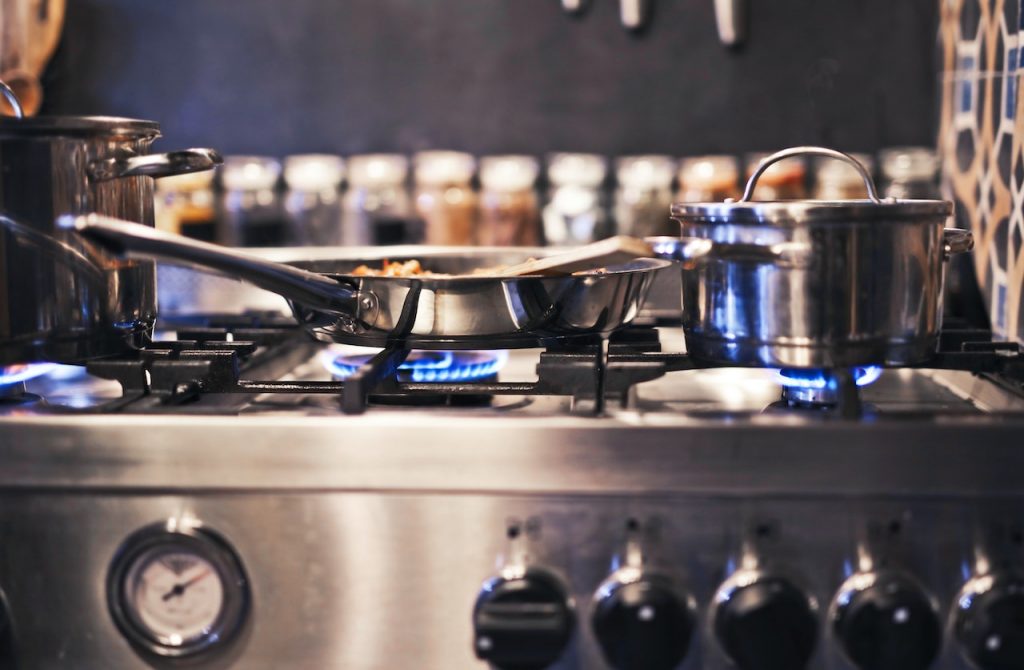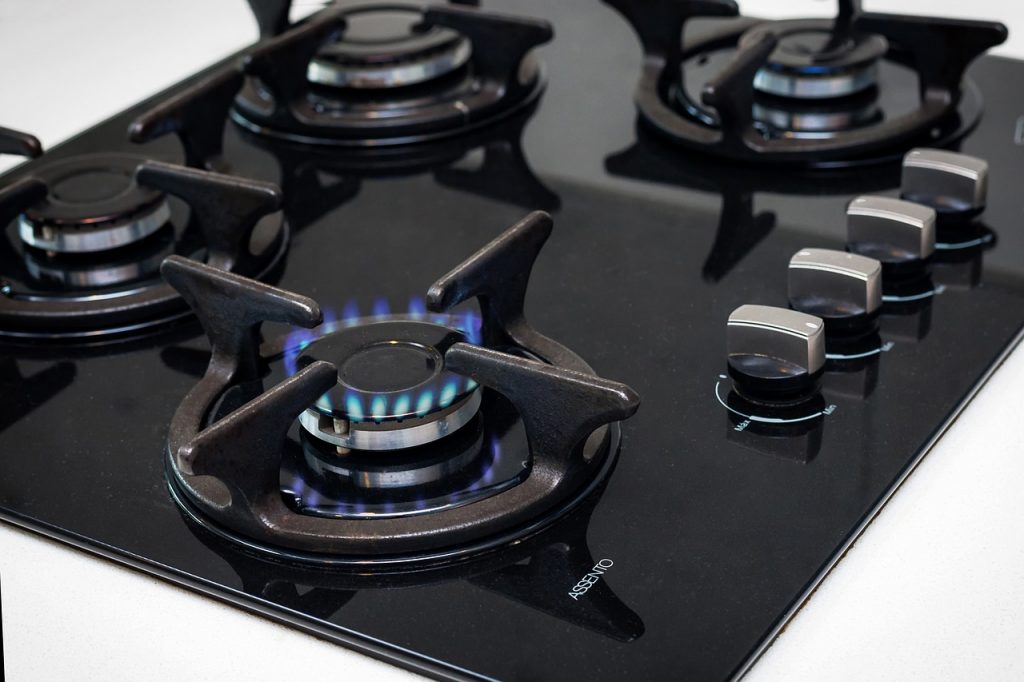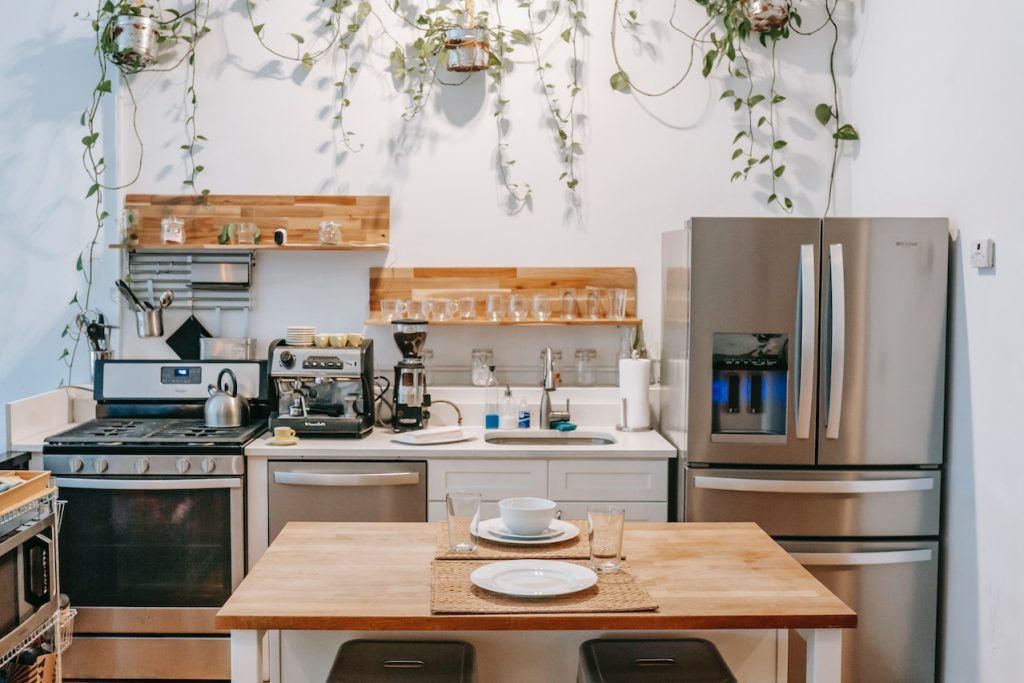Your kitchen is one of the busiest rooms in your home, and the stove is probably the most used appliance in the kitchen. Whether cooking a big meal or just heating a quick snack, grease can quickly build up on your stovetop.
Though no one likes a greasy stove, sometimes it feels like no matter how much you clean, the grease keeps coming back. In most households, grime, dirt, and grease are simply part of life; keeping things clean requires expertise and effort. But worry no more; this post will guide you on how to how to get rid of grease on stove.
Why Does Grease Build Up on Stoves?

Have you ever wondered why grease accumulates on stoves more than any other kitchen surface? It’s not just your imagination—grease builds up more on stoves than on countertops, cabinets, or floors. But why is that? Let’s take a closer look at the science behind this kitchen conundrum.
The explanation for this phenomenon actually has two parts.
First, when the grease heats up, it becomes less dense and more liquid-like. That means that when you’re cooking with grease on the stove, some of it will inevitably end up in the air as tiny droplets.
Those droplets of grease are attracted to cold surfaces. So even though you may not see them, they’re actually clinging to the stovetop (or range hood, if you have one) and slowly building up over time.
To make matters worse, once grease has built up on a surface, it becomes much easier for new grease to stick to. That’s because the old grease creates a sort of “grease layer” that acts as a barrier between the new grease and the stove surface. This barrier makes it harder for the new grease to be absorbed by the stovetop material, so it just sits on top of the old grease and continues to accumulate.
Why Is It Important to Get Rid of Grease on Stove?
Aside from the fact that a greasy stovetop is just plain icky, there are actually some very good reasons to keep your stove as clean as possible.
❕Grease Is Flammable
Anytime you cook, grease will inevitably end up on your stove. While it may seem harmless, this grease can be quite dangerous. Grease is highly flammable, and it can quickly ignite if it comes into contact with a heat source. In addition, grease can also build up over time and create a fire hazard. Even if you think your stove is clean, a grease build-up can quickly become dangerous.
❕Grease Can Contaminate Food
If you don’t clean the grease off your stove, it can contaminate your food. Grease can get onto utensils, pots, and pans you use to cook. The grease can also get into the food that you are cooking. If you are cooking meat, the grease can cause the meat to be contaminated. The fat in the grease can also cause the food to be oily and unhealthy.
❕Grease Can Attract Bugs
Bugs are attracted to the grease and can lay their eggs in it. When the eggs hatch, the bugs will start to multiply. If you have a lot of bugs in your kitchen, it can be very difficult to get rid of them.
❕It Can Damage Stove Top
Grease on the stove can damage the stovetop. When grease gets heated, it can cause the stove top to crack. Cracks on the stovetop can not only be unsightly, but they can also be dangerous. Cracks can provide a place for bacteria to grow and can also be a trip hazard. In addition, cracks can allow heat to escape, making your stove less efficient.
How to Get Rid of Grease on Stove

If you’ve already cleaned a stove, you know how frustrating it may be to get all the grease and grime off only to have it come back again in a few days.
The trick is to keep cleaning until all grease has been cleared. Often, more than once is necessary. Here’s a guide on the best way to remove grease from the stove:
Flour
When it comes to cooking, grease spills are inevitable. But if you’re not careful, those grease spills can cause serious problems. The first thing you need to do is clean up the spill immediately. Otherwise, the grease will seep into the fabric and become impossible to remove. One way to clean up a grease spill is to sprinkle flour over the area. The flour will absorb the grease and make it easier to wipe up. However, keep in mind that the grease must not be dry for this to work.
- Sprinkle a generous amount of flour over the grease spill.
- Allow the flour to sit for about 5-10 minutes.
- Use a paper towel to blot up the flour and grease.
- Repeat as necessary until the area is clean.
- Vinegar
Dishwashing Liquid
The dishwashing liquid will help break do the grease. The hot water will loosen the grease and make it easier to remove. The microfiber cloths will help trap the grease and dirt so you can easily wipe it away. Here’s how to do it:
- Use boiled water to moisten the microfiber cloth.
- Warm water simply doesn’t work in this situation since the increased temperature will effectively release any smudged grease. But be careful not to burn yourself in the process.
- Apply the wet microfiber cloth on the stovetop to clean it. Continue as needed.
- If it doesn’t seem to be working, add a few drops of dishwashing liquid on the microfiber cloth and then apply it on the stovetop.
- Repeat the process until the stovetop is clean.
- Use a damp microfiber cloth to wipe away any dishwashing liquid residue.
- Then, use a second microfiber cloth to buff and dry the stovetop.
- 3 to 5 minutes should be given for the paste to rest.
Water and Baking Soda
Baking soda is known as an excellent all-purpose cleaner for many household tasks. When combined with water, it may be used to remove grease that is difficult to get off and corrosion from coffee, juice, and copper from any surfaces.
Since baking soda is indeed an alkali, it effectively dissolves grease. Additionally, its mildness eliminates grease without harming the surfaces you’re trying to clean.
- Fill a small bowl with baking soda and water.
- Add a bit of additional water if the mixture has become too sticky. More baking soda may be added if it’s too watery.
- Wet a microfiber cloth with the mixture.
- Rub the stovetop with it in a circular motion.
- Allow the mixture to stay on the stovetop for about 3 minutes.
- Rinse it off with water, then dry it using a second microfiber cloth.
Vinegar
Vinegar may be the answer if you’re struggling to remove caked-on grease stains from your stove. White vinegar is a powerful cleaning agent that can break down stubborn grime.
- Simply mix equal parts vinegar and water in a spray bottle and mist the solution onto the stained area.
- Let it sit for a few minutes to loosen the grease, then wipe it away with a clean cloth or sponge.
- You may need to apply the solution several times to remove all the stains.
- You can use full-strength vinegar if you’re dealing with a particularly tough stain.
- Be careful when using this method, as vinegar is highly acidic and can damage some surfaces.
Taking Care of Your Stove

While stoves are built to last, they still need to be properly maintained. Taking care of your stove will prolong its lifespan and ensure that it works properly when you need it. Here are a few tips on how to take care of your stove:
✔️Clean the stovetop after each use.
This will prevent spills and splatters from being baked on and becoming difficult to clean. Use mild soap and warm water to clean the stovetop. You can also use a stove top cleaner if you have one.
✔️Wipe down the control panel with a damp cloth at least once a week.
This will remove any dirt or fingerprints accumulated on the control panel. Be careful only to press the buttons while cleaning the control panel.
✔️Clean the stove regularly
At least once a month, you should give your oven a thorough cleaning. It includes cleaning the stove top, oven door, control panel, and racks. Using baking soda and water, you can use a commercial oven cleaner or make your own cleaning solution.
✔️Check the gas lines and hoses regularly for leaks.
Call a professional immediately if you smell gas, as this could be dangerous. Regularly checking for leaks will help prevent any accidents from happening.
✔️Get your stove regularly serviced by a professional.
They will be able to clean places you cannot reach and spot any potential problems with your stove that you may not be aware of.
Frequently Asked Questions
How do you remove baked-on grease from an enamel stove top?
If your stovetop is covered in baked-on grease, there’s no need to fear — with a little elbow grease and the right cleaning supplies.
- First, give the surface a good scrub with a sponge or brush and some hot, soapy water.
- If that doesn’t do the trick, you can try making a paste out of baking soda and water and scrubbing the grease with that.
- You can also try using a commercial oven cleaner for stubborn stains.
- Simply apply the cleaner to the surface and let it sit for the recommended amount of time before wiping it away.
How do you clean burned food stains on a stovetop?
Burned food can be a real pain to clean up. However, here are a few simple steps to get your stove top to look like new again.
- Use a spatula or other blunt object to scrape away as much of the burned food as possible.
- Next, soak a sponge in warm soapy water and use it to scrub the stain.
- If the stain persists, mix together equal parts baking soda and water to form a paste, then apply the paste to the stain and let it sit before scrubbing again.
- Afterward, rinse the area with clean water, then dry it with a soft cloth.
How do you get black grease off your stovetop?
Even if you wipe the stovetop down immediately, that black grease can seem impossible to remove. However, there are a few strategies that can help.
One is to mix a paste of baking soda and water, then apply it to the grease stain and scrub with a sponge. You can also try making a vinegar solution by mixing equal parts vinegar and water.
- First, heat the vinegar solution on the stove, then apply it to the grease and let it sit for a few minutes.
- After that, you should be able to wipe the grease away with a damp cloth.
- If you have a stainless steel stovetop, you can try using rubbing alcohol. Just apply it to a rag and rub it in a circular motion until the grease is gone.
Can you use scrub daddy on a glass-top stove?
Scrub Daddy is a popular sponge often touted for its ability to clean surfaces without scratching them. However, it’s important to note that Scrub Daddy is not recommended for use on glass-top stoves. The company specifically states that the sponge should not be used on delicate surfaces like glass or stainless steel.
So, if you’re looking for a cleaner for your glass-top stove, you’ll need to find something else. There are plenty of other options out there, so don’t worry – you’ll be able to find something that works well for your needs.
Does dawn dish soap dissolve grease?
Dish soap is a versatile product used to clean everything from dishes to cars. Dish soap is effective at dissolving grease because it contains surfactants. Surfactants are molecules that have a hydrophilic (water-loving) head and a hydrophobic (oil-loving) tail. When dish soap is added to water, the surfactants line up at the interface between the water and the grease.
The hydrophobic tails point toward the grease, while the hydrophilic heads point toward the water. This allows the dish soap to break through the grease, leaving your dishes sparkling clean.
Final Words
There you have it! Now you know how to get rid of grease on stove. Simply follow the steps outlined above, and your stovetop will look new in no time. Thanks for reading!

